Semester 2 2019 ICT50415: VoIP Protocols and Codecs Practical Exercise
VerifiedAdded on 2022/10/06
|10
|2871
|16
Practical Assignment
AI Summary
This document details a practical exercise on VoIP systems, protocols, and codecs conducted by a student in the Department of Computing and Information Technology. The assignment covers various aspects of VoIP, including its advantages and disadvantages compared to PSTN systems, and the roles of different protocols and codecs. It includes research on VoIP basics, protocols like SIP and H.323, codecs such as G.711, and hardware components in VoIP systems. The student addresses questions related to network operating systems, VoIP implementation, bandwidth considerations, and real-time protocols (RTP/RTCP). The exercise involves analyzing factors affecting bandwidth and calculating bandwidth usage for mentioned codecs. The student also researches and analyzes the terms "Protocols" and "Codecs" as they relate to VoIP systems and hardware commonly implemented within VoIP systems.
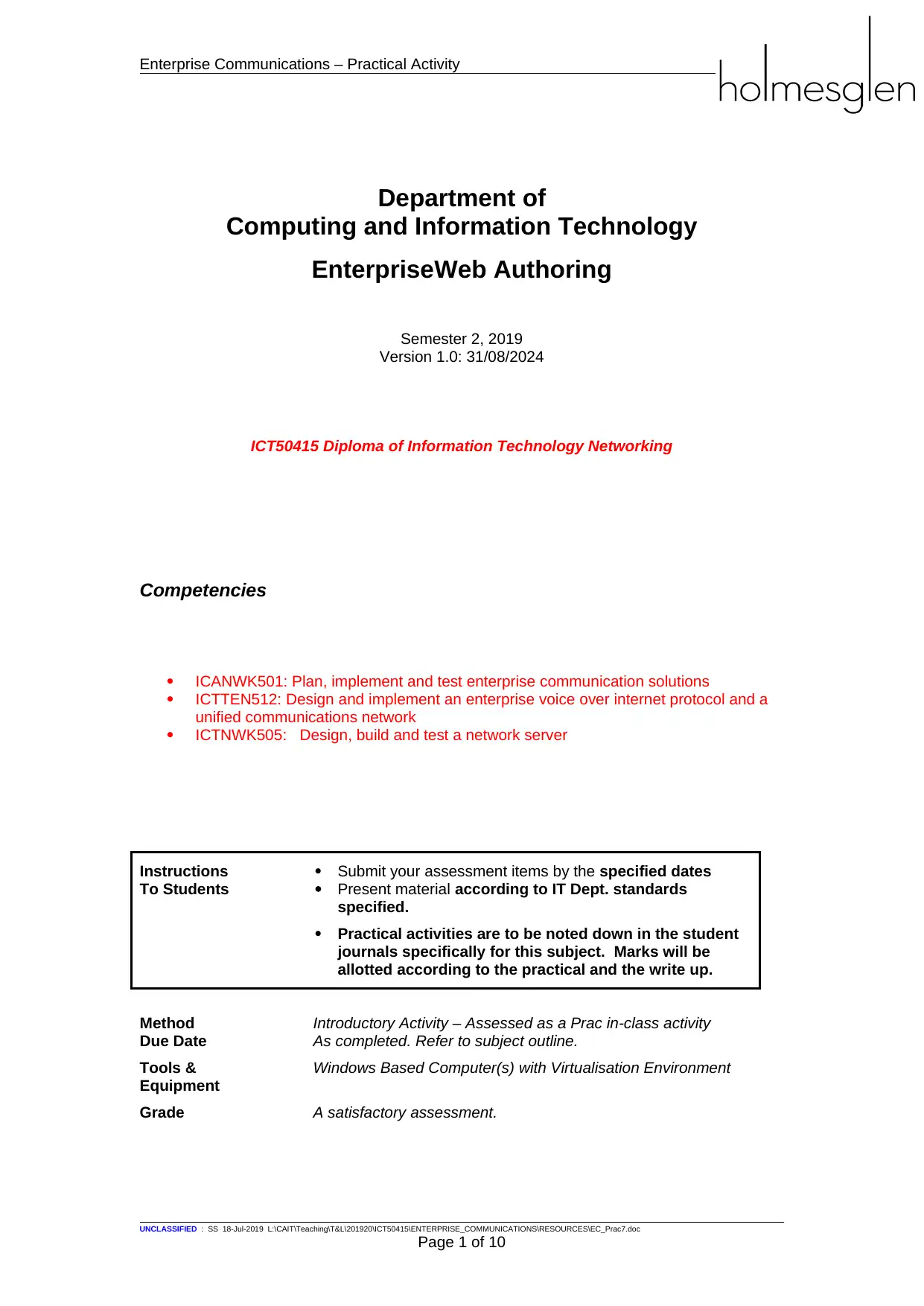
Enterprise Communications – Practical Activity
Department of
Computing and Information Technology
EnterpriseWeb Authoring
Semester 2, 2019
Version 1.0: 31/08/2024
ICT50415 Diploma of Information Technology Networking
Competencies
ICANWK501: Plan, implement and test enterprise communication solutions
ICTTEN512: Design and implement an enterprise voice over internet protocol and a
unified communications network
ICTNWK505: Design, build and test a network server
Instructions
To Students
Submit your assessment items by the specified dates
Present material according to IT Dept. standards
specified.
Practical activities are to be noted down in the student
journals specifically for this subject. Marks will be
allotted according to the practical and the write up.
Method Introductory Activity – Assessed as a Prac in-class activity
Due Date As completed. Refer to subject outline.
Tools &
Equipment
Windows Based Computer(s) with Virtualisation Environment
Grade A satisfactory assessment.
UNCLASSIFIED : SS 18-Jul-2019 L:\CAIT\Teaching\T&L\201920\ICT50415\ENTERPRISE_COMMUNICATIONS\RESOURCES\EC_Prac7.doc
Page 1 of 10
Department of
Computing and Information Technology
EnterpriseWeb Authoring
Semester 2, 2019
Version 1.0: 31/08/2024
ICT50415 Diploma of Information Technology Networking
Competencies
ICANWK501: Plan, implement and test enterprise communication solutions
ICTTEN512: Design and implement an enterprise voice over internet protocol and a
unified communications network
ICTNWK505: Design, build and test a network server
Instructions
To Students
Submit your assessment items by the specified dates
Present material according to IT Dept. standards
specified.
Practical activities are to be noted down in the student
journals specifically for this subject. Marks will be
allotted according to the practical and the write up.
Method Introductory Activity – Assessed as a Prac in-class activity
Due Date As completed. Refer to subject outline.
Tools &
Equipment
Windows Based Computer(s) with Virtualisation Environment
Grade A satisfactory assessment.
UNCLASSIFIED : SS 18-Jul-2019 L:\CAIT\Teaching\T&L\201920\ICT50415\ENTERPRISE_COMMUNICATIONS\RESOURCES\EC_Prac7.doc
Page 1 of 10
Paraphrase This Document
Need a fresh take? Get an instant paraphrase of this document with our AI Paraphraser
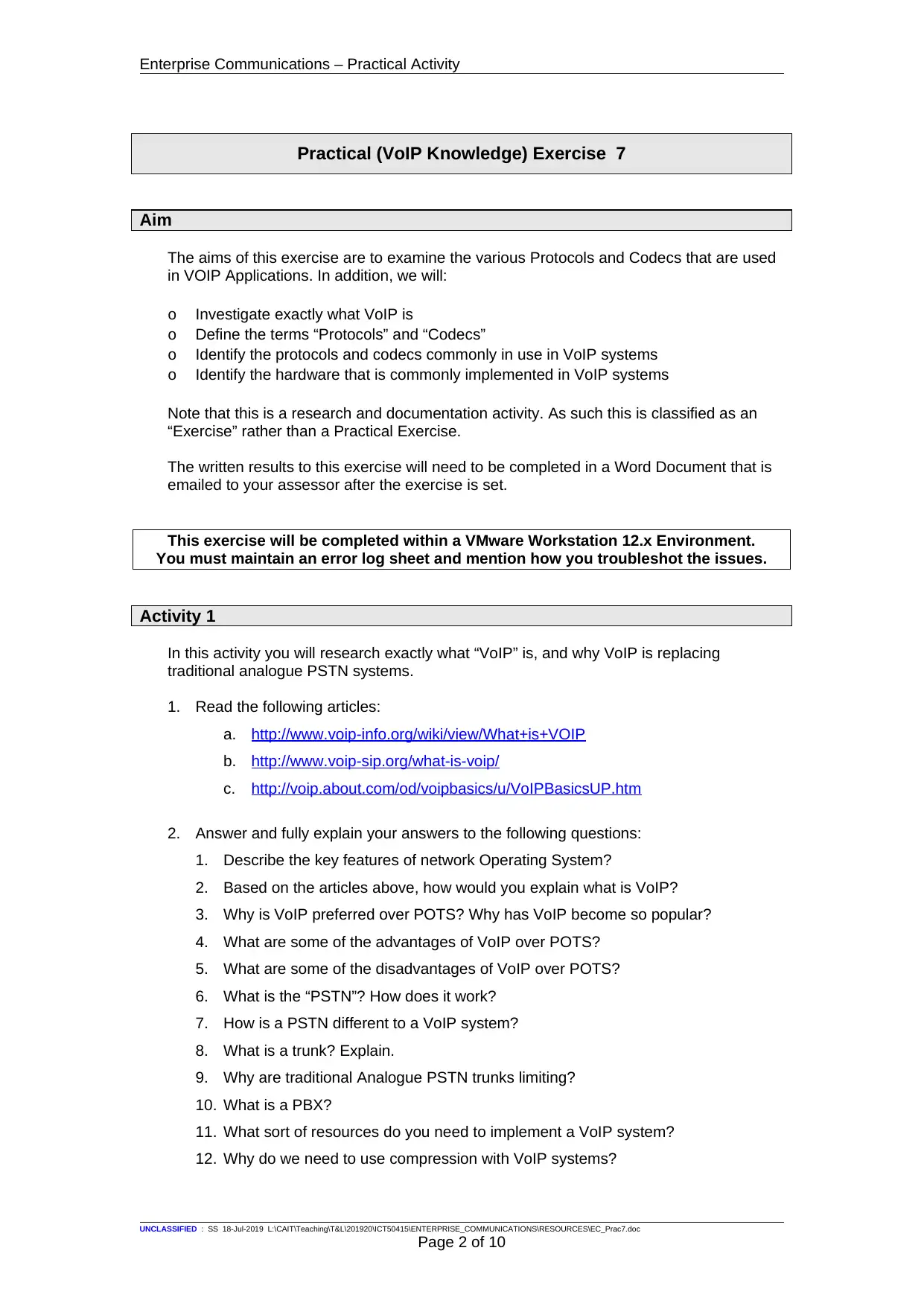
Enterprise Communications – Practical Activity
Practical (VoIP Knowledge) Exercise 7
Aim
The aims of this exercise are to examine the various Protocols and Codecs that are used
in VOIP Applications. In addition, we will:
o Investigate exactly what VoIP is
o Define the terms “Protocols” and “Codecs”
o Identify the protocols and codecs commonly in use in VoIP systems
o Identify the hardware that is commonly implemented in VoIP systems
Note that this is a research and documentation activity. As such this is classified as an
“Exercise” rather than a Practical Exercise.
The written results to this exercise will need to be completed in a Word Document that is
emailed to your assessor after the exercise is set.
This exercise will be completed within a VMware Workstation 12.x Environment.
You must maintain an error log sheet and mention how you troubleshot the issues.
Activity 1
In this activity you will research exactly what “VoIP” is, and why VoIP is replacing
traditional analogue PSTN systems.
1. Read the following articles:
a. http://www.voip-info.org/wiki/view/What+is+VOIP
b. http://www.voip-sip.org/what-is-voip/
c. http://voip.about.com/od/voipbasics/u/VoIPBasicsUP.htm
2. Answer and fully explain your answers to the following questions:
1. Describe the key features of network Operating System?
2. Based on the articles above, how would you explain what is VoIP?
3. Why is VoIP preferred over POTS? Why has VoIP become so popular?
4. What are some of the advantages of VoIP over POTS?
5. What are some of the disadvantages of VoIP over POTS?
6. What is the “PSTN”? How does it work?
7. How is a PSTN different to a VoIP system?
8. What is a trunk? Explain.
9. Why are traditional Analogue PSTN trunks limiting?
10. What is a PBX?
11. What sort of resources do you need to implement a VoIP system?
12. Why do we need to use compression with VoIP systems?
UNCLASSIFIED : SS 18-Jul-2019 L:\CAIT\Teaching\T&L\201920\ICT50415\ENTERPRISE_COMMUNICATIONS\RESOURCES\EC_Prac7.doc
Page 2 of 10
Practical (VoIP Knowledge) Exercise 7
Aim
The aims of this exercise are to examine the various Protocols and Codecs that are used
in VOIP Applications. In addition, we will:
o Investigate exactly what VoIP is
o Define the terms “Protocols” and “Codecs”
o Identify the protocols and codecs commonly in use in VoIP systems
o Identify the hardware that is commonly implemented in VoIP systems
Note that this is a research and documentation activity. As such this is classified as an
“Exercise” rather than a Practical Exercise.
The written results to this exercise will need to be completed in a Word Document that is
emailed to your assessor after the exercise is set.
This exercise will be completed within a VMware Workstation 12.x Environment.
You must maintain an error log sheet and mention how you troubleshot the issues.
Activity 1
In this activity you will research exactly what “VoIP” is, and why VoIP is replacing
traditional analogue PSTN systems.
1. Read the following articles:
a. http://www.voip-info.org/wiki/view/What+is+VOIP
b. http://www.voip-sip.org/what-is-voip/
c. http://voip.about.com/od/voipbasics/u/VoIPBasicsUP.htm
2. Answer and fully explain your answers to the following questions:
1. Describe the key features of network Operating System?
2. Based on the articles above, how would you explain what is VoIP?
3. Why is VoIP preferred over POTS? Why has VoIP become so popular?
4. What are some of the advantages of VoIP over POTS?
5. What are some of the disadvantages of VoIP over POTS?
6. What is the “PSTN”? How does it work?
7. How is a PSTN different to a VoIP system?
8. What is a trunk? Explain.
9. Why are traditional Analogue PSTN trunks limiting?
10. What is a PBX?
11. What sort of resources do you need to implement a VoIP system?
12. Why do we need to use compression with VoIP systems?
UNCLASSIFIED : SS 18-Jul-2019 L:\CAIT\Teaching\T&L\201920\ICT50415\ENTERPRISE_COMMUNICATIONS\RESOURCES\EC_Prac7.doc
Page 2 of 10

Enterprise Communications – Practical Activity
13. What is a “Codec”? List the most common “codecs” in use with VoIP systems,
detailing some of the features of each.
14. List and briefly explain the 5 most common protocols in use for VoIP systems
15. Investigate factors affecting bandwidth and calculate bandwidth usage for above
mentioned codecs, including considerations of overhead, connection quality and
connection speeds
Note that this course will primarily deal with the H.323/SIP and H.248/MGCP
Protocols
Activity 2
In this activity we will examine the H.323/SIP and H.248/MGCP Protocols in a little more
detail.
Read the following article:
http://www.packetizer.com/ipmc/papers/understanding_voip/voip_protocols.html
Answer and fully explain your answers to the following questions:
What is a “real time protocol” and how do they differ from operation with regards
to “normal” protocols?
Referring to RFC’s 3550 and 3551 (available as links in the first article) explain
the differences and functions of the RTP and RTCP.
Detail how the SIP protocol works.
What are some of the limitations of the SIP protocol?
What are the differences between SIP and MCGP?
What form of Protocol does “Skype” use?
Document your results in your Journal and email these to your teacher.
Activity 3
In this activity we will research and analyse the terms “Protocols” and “Codecs” as they
relate to VoIP systems. In particular, we will identify and describe some of the key
features of the main protocols and codecs employed in VoIP communication systems.
Answer the following questions, providing web references (where appropriate) with
each answer:
List (and briefly detail) the major protocols utilised under VoIP systems.
How do Codecs differ from Protocols?
List the major codecs in use in VoIP systems. List the major features of each
codec.
Detail the advantages and disadvantages of each codec.
Activity 4
UNCLASSIFIED : SS 18-Jul-2019 L:\CAIT\Teaching\T&L\201920\ICT50415\ENTERPRISE_COMMUNICATIONS\RESOURCES\EC_Prac7.doc
Page 3 of 10
13. What is a “Codec”? List the most common “codecs” in use with VoIP systems,
detailing some of the features of each.
14. List and briefly explain the 5 most common protocols in use for VoIP systems
15. Investigate factors affecting bandwidth and calculate bandwidth usage for above
mentioned codecs, including considerations of overhead, connection quality and
connection speeds
Note that this course will primarily deal with the H.323/SIP and H.248/MGCP
Protocols
Activity 2
In this activity we will examine the H.323/SIP and H.248/MGCP Protocols in a little more
detail.
Read the following article:
http://www.packetizer.com/ipmc/papers/understanding_voip/voip_protocols.html
Answer and fully explain your answers to the following questions:
What is a “real time protocol” and how do they differ from operation with regards
to “normal” protocols?
Referring to RFC’s 3550 and 3551 (available as links in the first article) explain
the differences and functions of the RTP and RTCP.
Detail how the SIP protocol works.
What are some of the limitations of the SIP protocol?
What are the differences between SIP and MCGP?
What form of Protocol does “Skype” use?
Document your results in your Journal and email these to your teacher.
Activity 3
In this activity we will research and analyse the terms “Protocols” and “Codecs” as they
relate to VoIP systems. In particular, we will identify and describe some of the key
features of the main protocols and codecs employed in VoIP communication systems.
Answer the following questions, providing web references (where appropriate) with
each answer:
List (and briefly detail) the major protocols utilised under VoIP systems.
How do Codecs differ from Protocols?
List the major codecs in use in VoIP systems. List the major features of each
codec.
Detail the advantages and disadvantages of each codec.
Activity 4
UNCLASSIFIED : SS 18-Jul-2019 L:\CAIT\Teaching\T&L\201920\ICT50415\ENTERPRISE_COMMUNICATIONS\RESOURCES\EC_Prac7.doc
Page 3 of 10
⊘ This is a preview!⊘
Do you want full access?
Subscribe today to unlock all pages.

Trusted by 1+ million students worldwide
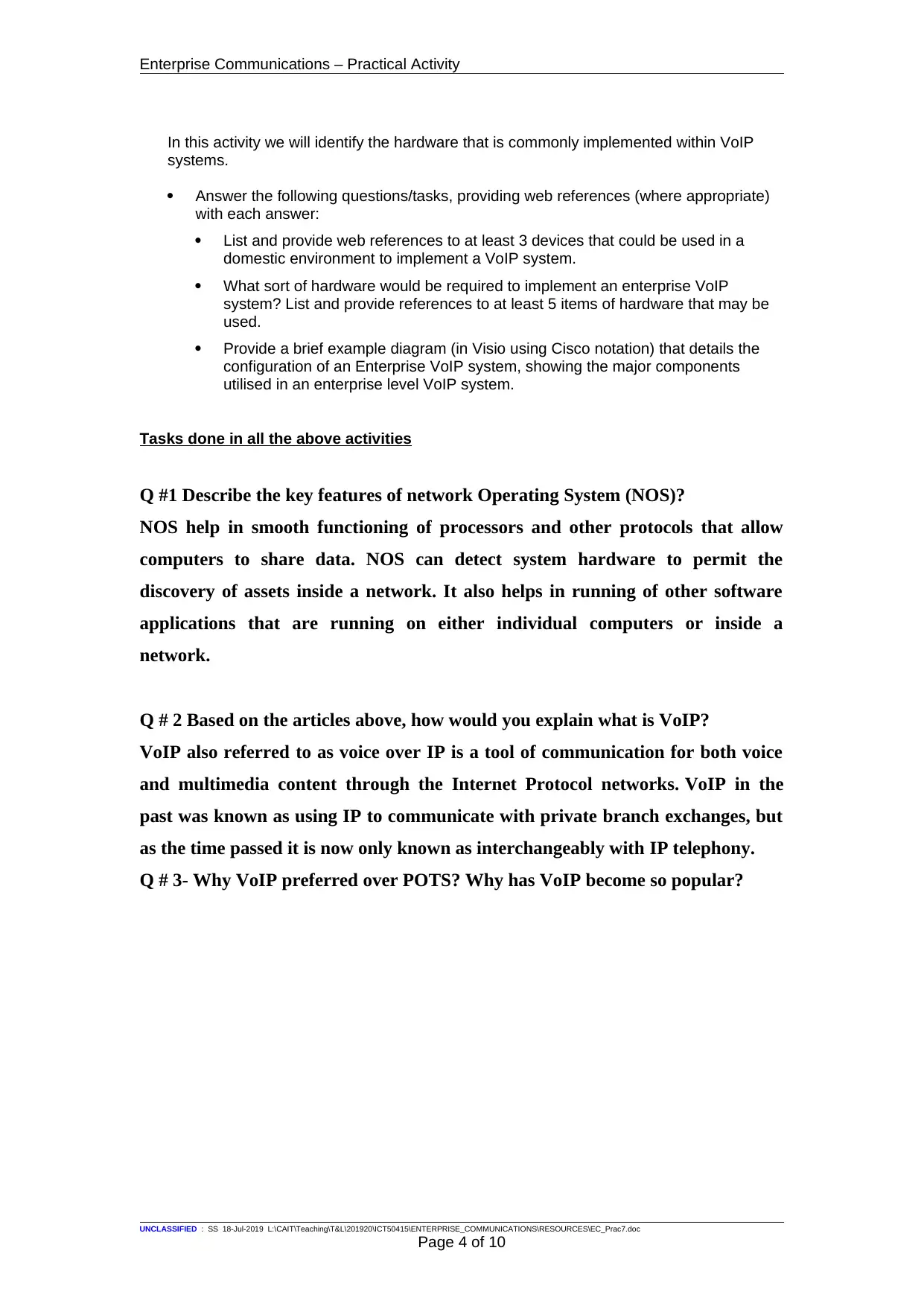
Enterprise Communications – Practical Activity
In this activity we will identify the hardware that is commonly implemented within VoIP
systems.
Answer the following questions/tasks, providing web references (where appropriate)
with each answer:
List and provide web references to at least 3 devices that could be used in a
domestic environment to implement a VoIP system.
What sort of hardware would be required to implement an enterprise VoIP
system? List and provide references to at least 5 items of hardware that may be
used.
Provide a brief example diagram (in Visio using Cisco notation) that details the
configuration of an Enterprise VoIP system, showing the major components
utilised in an enterprise level VoIP system.
Tasks done in all the above activities
Q #1 Describe the key features of network Operating System (NOS)?
NOS help in smooth functioning of processors and other protocols that allow
computers to share data. NOS can detect system hardware to permit the
discovery of assets inside a network. It also helps in running of other software
applications that are running on either individual computers or inside a
network.
Q # 2 Based on the articles above, how would you explain what is VoIP?
VoIP also referred to as voice over IP is a tool of communication for both voice
and multimedia content through the Internet Protocol networks. VoIP in the
past was known as using IP to communicate with private branch exchanges, but
as the time passed it is now only known as interchangeably with IP telephony.
Q # 3- Why VoIP preferred over POTS? Why has VoIP become so popular?
UNCLASSIFIED : SS 18-Jul-2019 L:\CAIT\Teaching\T&L\201920\ICT50415\ENTERPRISE_COMMUNICATIONS\RESOURCES\EC_Prac7.doc
Page 4 of 10
In this activity we will identify the hardware that is commonly implemented within VoIP
systems.
Answer the following questions/tasks, providing web references (where appropriate)
with each answer:
List and provide web references to at least 3 devices that could be used in a
domestic environment to implement a VoIP system.
What sort of hardware would be required to implement an enterprise VoIP
system? List and provide references to at least 5 items of hardware that may be
used.
Provide a brief example diagram (in Visio using Cisco notation) that details the
configuration of an Enterprise VoIP system, showing the major components
utilised in an enterprise level VoIP system.
Tasks done in all the above activities
Q #1 Describe the key features of network Operating System (NOS)?
NOS help in smooth functioning of processors and other protocols that allow
computers to share data. NOS can detect system hardware to permit the
discovery of assets inside a network. It also helps in running of other software
applications that are running on either individual computers or inside a
network.
Q # 2 Based on the articles above, how would you explain what is VoIP?
VoIP also referred to as voice over IP is a tool of communication for both voice
and multimedia content through the Internet Protocol networks. VoIP in the
past was known as using IP to communicate with private branch exchanges, but
as the time passed it is now only known as interchangeably with IP telephony.
Q # 3- Why VoIP preferred over POTS? Why has VoIP become so popular?
UNCLASSIFIED : SS 18-Jul-2019 L:\CAIT\Teaching\T&L\201920\ICT50415\ENTERPRISE_COMMUNICATIONS\RESOURCES\EC_Prac7.doc
Page 4 of 10
Paraphrase This Document
Need a fresh take? Get an instant paraphrase of this document with our AI Paraphraser
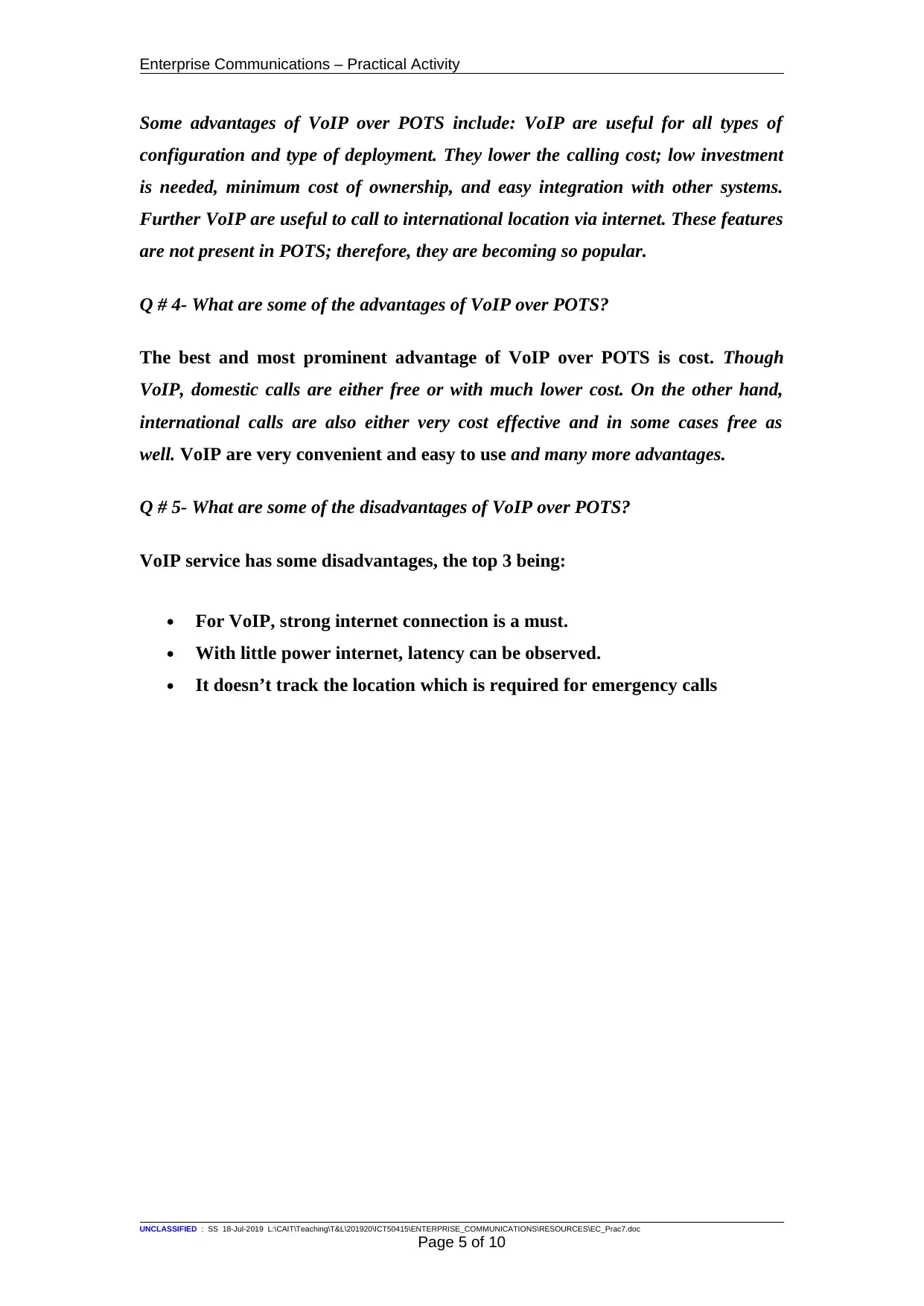
Enterprise Communications – Practical Activity
Some advantages of VoIP over POTS include: VoIP are useful for all types of
configuration and type of deployment. They lower the calling cost; low investment
is needed, minimum cost of ownership, and easy integration with other systems.
Further VoIP are useful to call to international location via internet. These features
are not present in POTS; therefore, they are becoming so popular.
Q # 4- What are some of the advantages of VoIP over POTS?
The best and most prominent advantage of VoIP over POTS is cost. Though
VoIP, domestic calls are either free or with much lower cost. On the other hand,
international calls are also either very cost effective and in some cases free as
well. VoIP are very convenient and easy to use and many more advantages.
Q # 5- What are some of the disadvantages of VoIP over POTS?
VoIP service has some disadvantages, the top 3 being:
For VoIP, strong internet connection is a must.
With little power internet, latency can be observed.
It doesn’t track the location which is required for emergency calls
UNCLASSIFIED : SS 18-Jul-2019 L:\CAIT\Teaching\T&L\201920\ICT50415\ENTERPRISE_COMMUNICATIONS\RESOURCES\EC_Prac7.doc
Page 5 of 10
Some advantages of VoIP over POTS include: VoIP are useful for all types of
configuration and type of deployment. They lower the calling cost; low investment
is needed, minimum cost of ownership, and easy integration with other systems.
Further VoIP are useful to call to international location via internet. These features
are not present in POTS; therefore, they are becoming so popular.
Q # 4- What are some of the advantages of VoIP over POTS?
The best and most prominent advantage of VoIP over POTS is cost. Though
VoIP, domestic calls are either free or with much lower cost. On the other hand,
international calls are also either very cost effective and in some cases free as
well. VoIP are very convenient and easy to use and many more advantages.
Q # 5- What are some of the disadvantages of VoIP over POTS?
VoIP service has some disadvantages, the top 3 being:
For VoIP, strong internet connection is a must.
With little power internet, latency can be observed.
It doesn’t track the location which is required for emergency calls
UNCLASSIFIED : SS 18-Jul-2019 L:\CAIT\Teaching\T&L\201920\ICT50415\ENTERPRISE_COMMUNICATIONS\RESOURCES\EC_Prac7.doc
Page 5 of 10
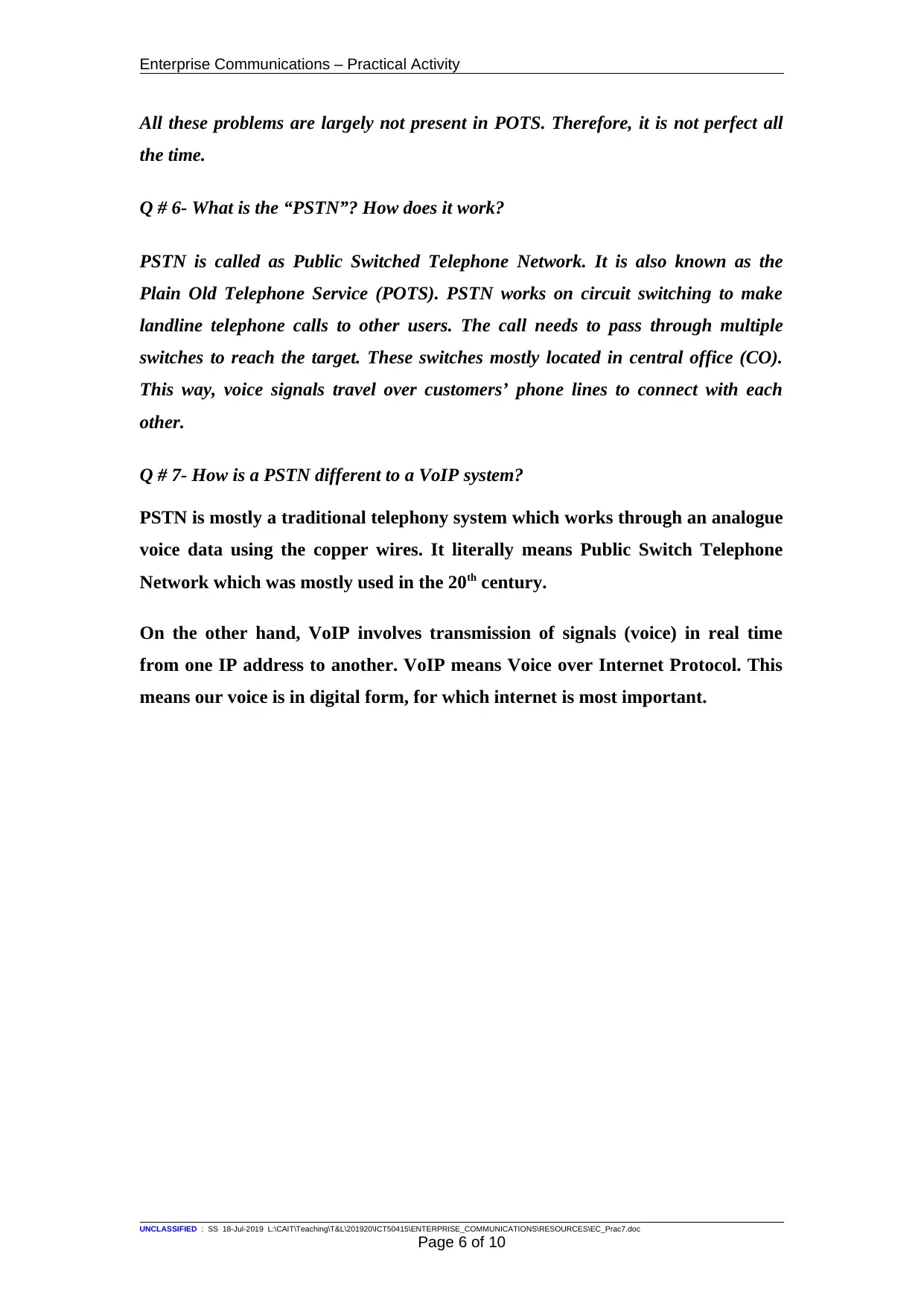
Enterprise Communications – Practical Activity
All these problems are largely not present in POTS. Therefore, it is not perfect all
the time.
Q # 6- What is the “PSTN”? How does it work?
PSTN is called as Public Switched Telephone Network. It is also known as the
Plain Old Telephone Service (POTS). PSTN works on circuit switching to make
landline telephone calls to other users. The call needs to pass through multiple
switches to reach the target. These switches mostly located in central office (CO).
This way, voice signals travel over customers’ phone lines to connect with each
other.
Q # 7- How is a PSTN different to a VoIP system?
PSTN is mostly a traditional telephony system which works through an analogue
voice data using the copper wires. It literally means Public Switch Telephone
Network which was mostly used in the 20th century.
On the other hand, VoIP involves transmission of signals (voice) in real time
from one IP address to another. VoIP means Voice over Internet Protocol. This
means our voice is in digital form, for which internet is most important.
UNCLASSIFIED : SS 18-Jul-2019 L:\CAIT\Teaching\T&L\201920\ICT50415\ENTERPRISE_COMMUNICATIONS\RESOURCES\EC_Prac7.doc
Page 6 of 10
All these problems are largely not present in POTS. Therefore, it is not perfect all
the time.
Q # 6- What is the “PSTN”? How does it work?
PSTN is called as Public Switched Telephone Network. It is also known as the
Plain Old Telephone Service (POTS). PSTN works on circuit switching to make
landline telephone calls to other users. The call needs to pass through multiple
switches to reach the target. These switches mostly located in central office (CO).
This way, voice signals travel over customers’ phone lines to connect with each
other.
Q # 7- How is a PSTN different to a VoIP system?
PSTN is mostly a traditional telephony system which works through an analogue
voice data using the copper wires. It literally means Public Switch Telephone
Network which was mostly used in the 20th century.
On the other hand, VoIP involves transmission of signals (voice) in real time
from one IP address to another. VoIP means Voice over Internet Protocol. This
means our voice is in digital form, for which internet is most important.
UNCLASSIFIED : SS 18-Jul-2019 L:\CAIT\Teaching\T&L\201920\ICT50415\ENTERPRISE_COMMUNICATIONS\RESOURCES\EC_Prac7.doc
Page 6 of 10
⊘ This is a preview!⊘
Do you want full access?
Subscribe today to unlock all pages.

Trusted by 1+ million students worldwide
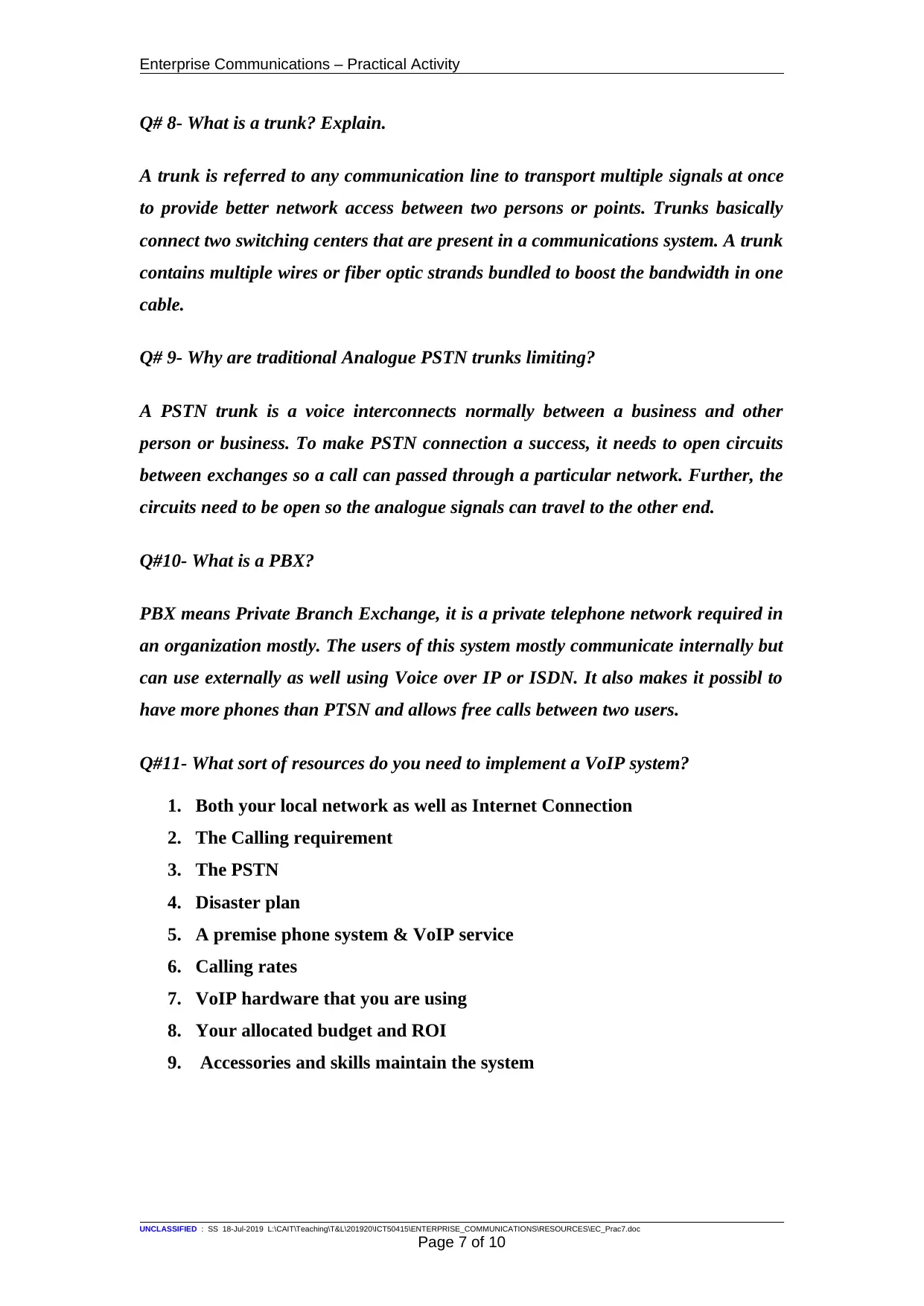
Enterprise Communications – Practical Activity
Q# 8- What is a trunk? Explain.
A trunk is referred to any communication line to transport multiple signals at once
to provide better network access between two persons or points. Trunks basically
connect two switching centers that are present in a communications system. A trunk
contains multiple wires or fiber optic strands bundled to boost the bandwidth in one
cable.
Q# 9- Why are traditional Analogue PSTN trunks limiting?
A PSTN trunk is a voice interconnects normally between a business and other
person or business. To make PSTN connection a success, it needs to open circuits
between exchanges so a call can passed through a particular network. Further, the
circuits need to be open so the analogue signals can travel to the other end.
Q#10- What is a PBX?
PBX means Private Branch Exchange, it is a private telephone network required in
an organization mostly. The users of this system mostly communicate internally but
can use externally as well using Voice over IP or ISDN. It also makes it possibl to
have more phones than PTSN and allows free calls between two users.
Q#11- What sort of resources do you need to implement a VoIP system?
1. Both your local network as well as Internet Connection
2. The Calling requirement
3. The PSTN
4. Disaster plan
5. A premise phone system & VoIP service
6. Calling rates
7. VoIP hardware that you are using
8. Your allocated budget and ROI
9. Accessories and skills maintain the system
UNCLASSIFIED : SS 18-Jul-2019 L:\CAIT\Teaching\T&L\201920\ICT50415\ENTERPRISE_COMMUNICATIONS\RESOURCES\EC_Prac7.doc
Page 7 of 10
Q# 8- What is a trunk? Explain.
A trunk is referred to any communication line to transport multiple signals at once
to provide better network access between two persons or points. Trunks basically
connect two switching centers that are present in a communications system. A trunk
contains multiple wires or fiber optic strands bundled to boost the bandwidth in one
cable.
Q# 9- Why are traditional Analogue PSTN trunks limiting?
A PSTN trunk is a voice interconnects normally between a business and other
person or business. To make PSTN connection a success, it needs to open circuits
between exchanges so a call can passed through a particular network. Further, the
circuits need to be open so the analogue signals can travel to the other end.
Q#10- What is a PBX?
PBX means Private Branch Exchange, it is a private telephone network required in
an organization mostly. The users of this system mostly communicate internally but
can use externally as well using Voice over IP or ISDN. It also makes it possibl to
have more phones than PTSN and allows free calls between two users.
Q#11- What sort of resources do you need to implement a VoIP system?
1. Both your local network as well as Internet Connection
2. The Calling requirement
3. The PSTN
4. Disaster plan
5. A premise phone system & VoIP service
6. Calling rates
7. VoIP hardware that you are using
8. Your allocated budget and ROI
9. Accessories and skills maintain the system
UNCLASSIFIED : SS 18-Jul-2019 L:\CAIT\Teaching\T&L\201920\ICT50415\ENTERPRISE_COMMUNICATIONS\RESOURCES\EC_Prac7.doc
Page 7 of 10
Paraphrase This Document
Need a fresh take? Get an instant paraphrase of this document with our AI Paraphraser
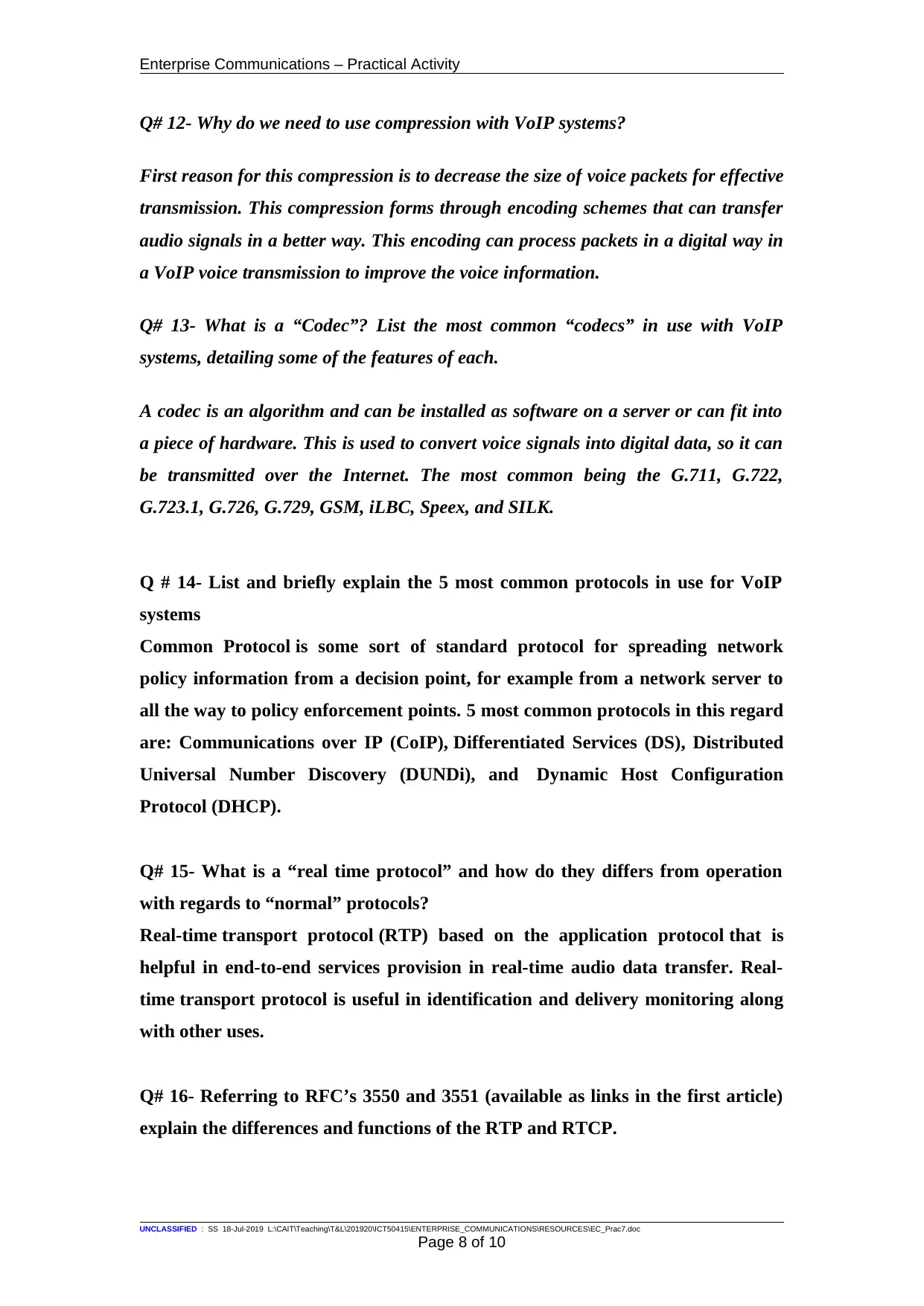
Enterprise Communications – Practical Activity
Q# 12- Why do we need to use compression with VoIP systems?
First reason for this compression is to decrease the size of voice packets for effective
transmission. This compression forms through encoding schemes that can transfer
audio signals in a better way. This encoding can process packets in a digital way in
a VoIP voice transmission to improve the voice information.
Q# 13- What is a “Codec”? List the most common “codecs” in use with VoIP
systems, detailing some of the features of each.
A codec is an algorithm and can be installed as software on a server or can fit into
a piece of hardware. This is used to convert voice signals into digital data, so it can
be transmitted over the Internet. The most common being the G.711, G.722,
G.723.1, G.726, G.729, GSM, iLBC, Speex, and SILK.
Q # 14- List and briefly explain the 5 most common protocols in use for VoIP
systems
Common Protocol is some sort of standard protocol for spreading network
policy information from a decision point, for example from a network server to
all the way to policy enforcement points. 5 most common protocols in this regard
are: Communications over IP (CoIP), Differentiated Services (DS), Distributed
Universal Number Discovery (DUNDi), and Dynamic Host Configuration
Protocol (DHCP).
Q# 15- What is a “real time protocol” and how do they differs from operation
with regards to “normal” protocols?
Real-time transport protocol (RTP) based on the application protocol that is
helpful in end-to-end services provision in real-time audio data transfer. Real-
time transport protocol is useful in identification and delivery monitoring along
with other uses.
Q# 16- Referring to RFC’s 3550 and 3551 (available as links in the first article)
explain the differences and functions of the RTP and RTCP.
UNCLASSIFIED : SS 18-Jul-2019 L:\CAIT\Teaching\T&L\201920\ICT50415\ENTERPRISE_COMMUNICATIONS\RESOURCES\EC_Prac7.doc
Page 8 of 10
Q# 12- Why do we need to use compression with VoIP systems?
First reason for this compression is to decrease the size of voice packets for effective
transmission. This compression forms through encoding schemes that can transfer
audio signals in a better way. This encoding can process packets in a digital way in
a VoIP voice transmission to improve the voice information.
Q# 13- What is a “Codec”? List the most common “codecs” in use with VoIP
systems, detailing some of the features of each.
A codec is an algorithm and can be installed as software on a server or can fit into
a piece of hardware. This is used to convert voice signals into digital data, so it can
be transmitted over the Internet. The most common being the G.711, G.722,
G.723.1, G.726, G.729, GSM, iLBC, Speex, and SILK.
Q # 14- List and briefly explain the 5 most common protocols in use for VoIP
systems
Common Protocol is some sort of standard protocol for spreading network
policy information from a decision point, for example from a network server to
all the way to policy enforcement points. 5 most common protocols in this regard
are: Communications over IP (CoIP), Differentiated Services (DS), Distributed
Universal Number Discovery (DUNDi), and Dynamic Host Configuration
Protocol (DHCP).
Q# 15- What is a “real time protocol” and how do they differs from operation
with regards to “normal” protocols?
Real-time transport protocol (RTP) based on the application protocol that is
helpful in end-to-end services provision in real-time audio data transfer. Real-
time transport protocol is useful in identification and delivery monitoring along
with other uses.
Q# 16- Referring to RFC’s 3550 and 3551 (available as links in the first article)
explain the differences and functions of the RTP and RTCP.
UNCLASSIFIED : SS 18-Jul-2019 L:\CAIT\Teaching\T&L\201920\ICT50415\ENTERPRISE_COMMUNICATIONS\RESOURCES\EC_Prac7.doc
Page 8 of 10
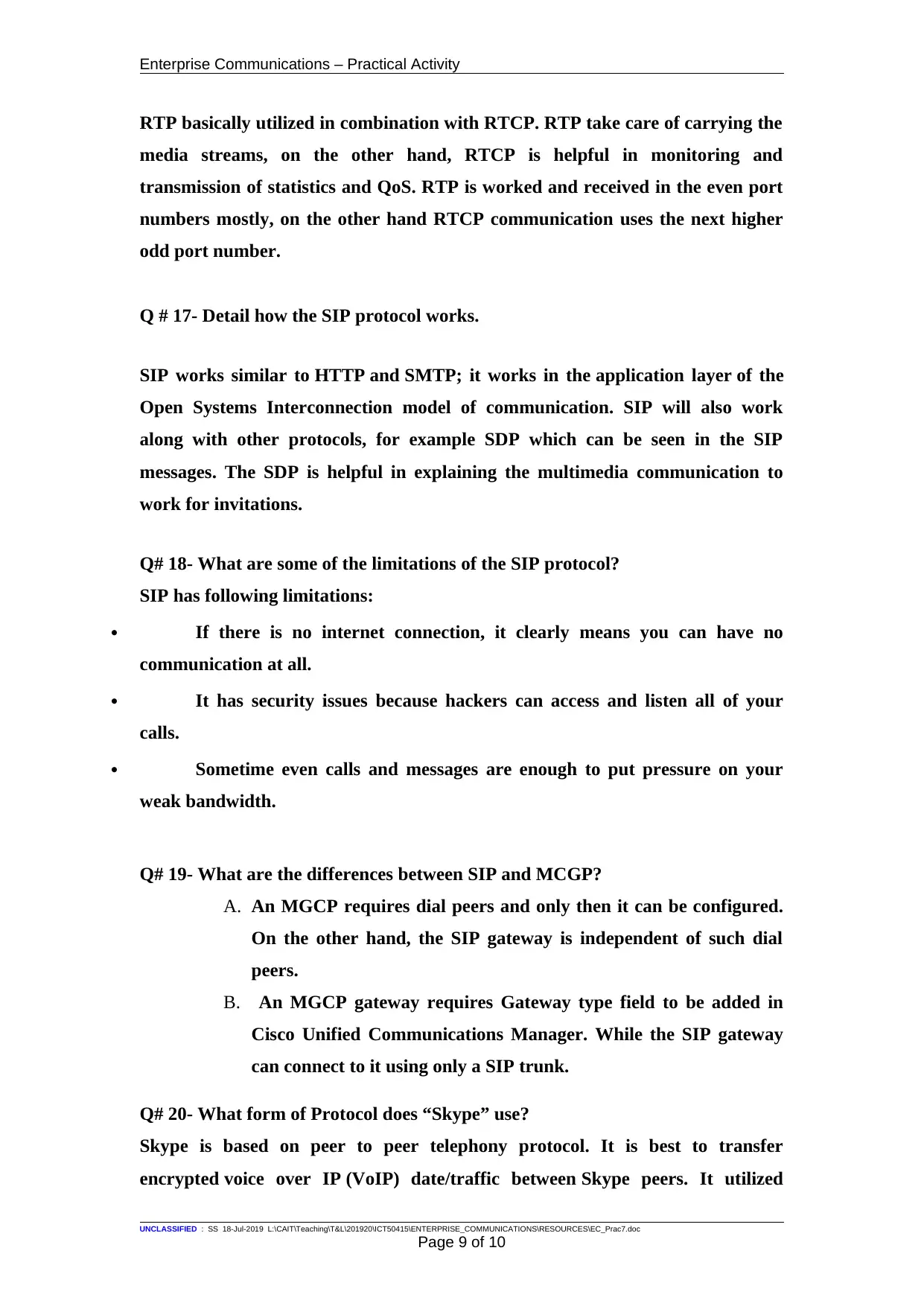
Enterprise Communications – Practical Activity
RTP basically utilized in combination with RTCP. RTP take care of carrying the
media streams, on the other hand, RTCP is helpful in monitoring and
transmission of statistics and QoS. RTP is worked and received in the even port
numbers mostly, on the other hand RTCP communication uses the next higher
odd port number.
Q # 17- Detail how the SIP protocol works.
SIP works similar to HTTP and SMTP; it works in the application layer of the
Open Systems Interconnection model of communication. SIP will also work
along with other protocols, for example SDP which can be seen in the SIP
messages. The SDP is helpful in explaining the multimedia communication to
work for invitations.
Q# 18- What are some of the limitations of the SIP protocol?
SIP has following limitations:
If there is no internet connection, it clearly means you can have no
communication at all.
It has security issues because hackers can access and listen all of your
calls.
Sometime even calls and messages are enough to put pressure on your
weak bandwidth.
Q# 19- What are the differences between SIP and MCGP?
A. An MGCP requires dial peers and only then it can be configured.
On the other hand, the SIP gateway is independent of such dial
peers.
B. An MGCP gateway requires Gateway type field to be added in
Cisco Unified Communications Manager. While the SIP gateway
can connect to it using only a SIP trunk.
Q# 20- What form of Protocol does “Skype” use?
Skype is based on peer to peer telephony protocol. It is best to transfer
encrypted voice over IP (VoIP) date/traffic between Skype peers. It utilized
UNCLASSIFIED : SS 18-Jul-2019 L:\CAIT\Teaching\T&L\201920\ICT50415\ENTERPRISE_COMMUNICATIONS\RESOURCES\EC_Prac7.doc
Page 9 of 10
RTP basically utilized in combination with RTCP. RTP take care of carrying the
media streams, on the other hand, RTCP is helpful in monitoring and
transmission of statistics and QoS. RTP is worked and received in the even port
numbers mostly, on the other hand RTCP communication uses the next higher
odd port number.
Q # 17- Detail how the SIP protocol works.
SIP works similar to HTTP and SMTP; it works in the application layer of the
Open Systems Interconnection model of communication. SIP will also work
along with other protocols, for example SDP which can be seen in the SIP
messages. The SDP is helpful in explaining the multimedia communication to
work for invitations.
Q# 18- What are some of the limitations of the SIP protocol?
SIP has following limitations:
If there is no internet connection, it clearly means you can have no
communication at all.
It has security issues because hackers can access and listen all of your
calls.
Sometime even calls and messages are enough to put pressure on your
weak bandwidth.
Q# 19- What are the differences between SIP and MCGP?
A. An MGCP requires dial peers and only then it can be configured.
On the other hand, the SIP gateway is independent of such dial
peers.
B. An MGCP gateway requires Gateway type field to be added in
Cisco Unified Communications Manager. While the SIP gateway
can connect to it using only a SIP trunk.
Q# 20- What form of Protocol does “Skype” use?
Skype is based on peer to peer telephony protocol. It is best to transfer
encrypted voice over IP (VoIP) date/traffic between Skype peers. It utilized
UNCLASSIFIED : SS 18-Jul-2019 L:\CAIT\Teaching\T&L\201920\ICT50415\ENTERPRISE_COMMUNICATIONS\RESOURCES\EC_Prac7.doc
Page 9 of 10
⊘ This is a preview!⊘
Do you want full access?
Subscribe today to unlock all pages.

Trusted by 1+ million students worldwide
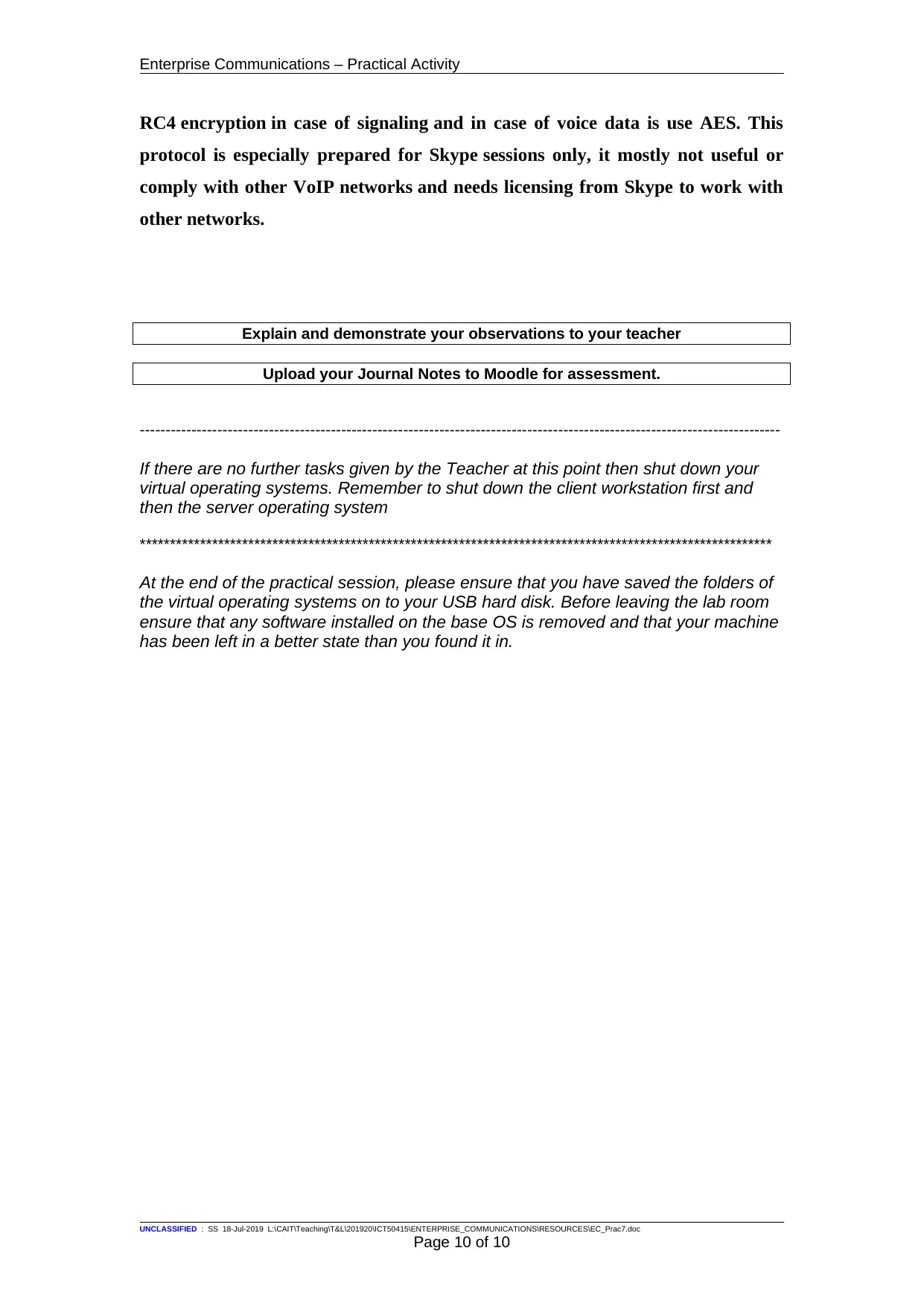
Enterprise Communications – Practical Activity
RC4 encryption in case of signaling and in case of voice data is use AES. This
protocol is especially prepared for Skype sessions only, it mostly not useful or
comply with other VoIP networks and needs licensing from Skype to work with
other networks.
Explain and demonstrate your observations to your teacher
Upload your Journal Notes to Moodle for assessment.
----------------------------------------------------------------------------------------------------------------------------
If there are no further tasks given by the Teacher at this point then shut down your
virtual operating systems. Remember to shut down the client workstation first and
then the server operating system
*********************************************************************************************************
At the end of the practical session, please ensure that you have saved the folders of
the virtual operating systems on to your USB hard disk. Before leaving the lab room
ensure that any software installed on the base OS is removed and that your machine
has been left in a better state than you found it in.
UNCLASSIFIED : SS 18-Jul-2019 L:\CAIT\Teaching\T&L\201920\ICT50415\ENTERPRISE_COMMUNICATIONS\RESOURCES\EC_Prac7.doc
Page 10 of 10
RC4 encryption in case of signaling and in case of voice data is use AES. This
protocol is especially prepared for Skype sessions only, it mostly not useful or
comply with other VoIP networks and needs licensing from Skype to work with
other networks.
Explain and demonstrate your observations to your teacher
Upload your Journal Notes to Moodle for assessment.
----------------------------------------------------------------------------------------------------------------------------
If there are no further tasks given by the Teacher at this point then shut down your
virtual operating systems. Remember to shut down the client workstation first and
then the server operating system
*********************************************************************************************************
At the end of the practical session, please ensure that you have saved the folders of
the virtual operating systems on to your USB hard disk. Before leaving the lab room
ensure that any software installed on the base OS is removed and that your machine
has been left in a better state than you found it in.
UNCLASSIFIED : SS 18-Jul-2019 L:\CAIT\Teaching\T&L\201920\ICT50415\ENTERPRISE_COMMUNICATIONS\RESOURCES\EC_Prac7.doc
Page 10 of 10
1 out of 10
Related Documents
Your All-in-One AI-Powered Toolkit for Academic Success.
+13062052269
info@desklib.com
Available 24*7 on WhatsApp / Email
![[object Object]](/_next/static/media/star-bottom.7253800d.svg)
Unlock your academic potential
Copyright © 2020–2025 A2Z Services. All Rights Reserved. Developed and managed by ZUCOL.





